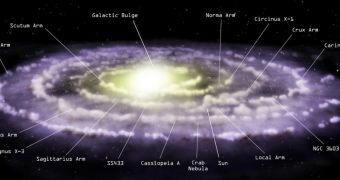For years, astronomers have been locked in a heated debate about how our galaxy formed. Several mechanisms have been proposed, some of them competing with each other. A recent investigation may contribute to quenching these discussions, arguing that the Milky Way formed from the inside out.
This conclusion is based on data obtained by the Gaia-ESO (European Southern Observatory) Public Spectroscopic survey, which keeps track of more than 100,000 stars in the Milky Way. The work is being conducted using the Fiber Large Array Multi-Element Spectrograph instrument.
FLAMES is attached to Unit Telescope 2 (Kueyen) at the ESO Very Large Telescope (VLT), at Cerro Paranal Observatory, in Chile. The VLT features a total of four, 8.2-meter (27-foot) unit telescopes, accompanied by 4 smaller telescopes for target acquisition.
Additional data for the Gaia-ESO survey are collected by the Visible and Infrared Survey Telescope for Astronomy (VISTA), also at Cerro Paranal, and by the Two Micron All-Sky Survey (2MASS). Targets include stars in the galactic bulge, disks, and halo, as well as a collection of 100 open star cluster.
Using this massive wealth of information, astronomers with the Gaia-ESO initiative and the Institute of Astronomy at Cambridge University were able to show that the chemical composition of stars in the galaxy reflects a scenario where the earliest celestial orbs formed in the inner regions of the Milky Way's galactic disk.
“The different chemical elements of which stars – and we – are made are created at different rates – some in massive stars which live fast and die young, and others in Sun-like stars with more sedate multi-billion-year lifetimes,” says Gaia-ESO lead project investigator, professor Gerry Gilmore.
“We have been able to shed new light on the timescale of chemical enrichment across the Milky Way disc, showing that outer regions of the disc take a much longer time to form,” adds IA professor and study leader, Maria Bergemann.
“This supports theoretical models for the formation of disc galaxies in the context of Cold Dark Matter cosmology, which predict that galaxy discs grow inside-out,” she concludes, quoted by Technology.
The conclusions of this study may be confirmed by the Gaia mission launched by the European Space Agency in mid-December 2013. The spacecraft will follow an ambitious plan of surveying around a billion stars in the Milky Way over the next five years.

 14 DAY TRIAL //
14 DAY TRIAL //